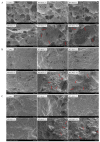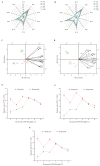Study on the Effect of Microwaved Brewer's Spent Grains on the Quality and Flavor Characteristics of Bread
- PMID: 38338596
- PMCID: PMC10855328
- DOI: 10.3390/foods13030461
Study on the Effect of Microwaved Brewer's Spent Grains on the Quality and Flavor Characteristics of Bread
Abstract
To enable a wider utilization of co-products from beer processing and minimize the negative effect of added grain on bread quality, flavor, and other attributes, brewer's spent grains (BSG) are processed through microwave pretreatment, and then the microwave-treated BSG (MW-BSG) is added to bread. So far, there has been no investigation on the effect of microwave-pretreated BSG on bread quality and flavor. In this study, we examined the effects of diverse microwave treatment variables on the physicochemical structure of BSG and explored the consequences of MW-BSG on the quality and flavor of bread. The results showed that soluble dietary fiber and water-soluble protein levels in MW-BSG increased significantly (144.88% and 23.35%) at a 540 W microwave power, 3 min processing time, and 1:5 material-liquid ratio of BSG to water. The proper addition of MW-BSG positively affected the bread texture properties and color, but excessive amounts led to an irregular size and distribution of the bread crumbs. The result of electronic nose and HS-SPME-GC-MS analyses showed that the addition of MW-BSG modified the odor profile of the bread. A sensory evaluation showed mean scores ranging from 6.81 to 4.41 for bread containing 0-10% MW-BSG. Consumers found a maximum level of 6% MW-BSG acceptable. This study endeavors to decrease environmental contamination caused by brewing waste by broadening the methods by which beer co-products can be utilized through an innovative approach.
Keywords: BSG; bread; dietary fiber; electronic nose; microwave treatment; protein; sensory evaluation.
Conflict of interest statement
The authors declare no conflict of interest.
Figures






Similar articles
-
Investigation of physicochemical, nutritional, and sensory qualities of muffins incorporated with dried brewer's spent grain flours as a source of dietary fiber and protein.J Food Sci. 2020 Nov;85(11):3943-3953. doi: 10.1111/1750-3841.15483. Epub 2020 Oct 10. J Food Sci. 2020. PMID: 33037629
-
Applicability of wheat brewer's spent grain in steamed bread-making based on physicochemical and visual profiles assessment of doughs and breads.Food Sci Technol Int. 2024 Jun 6:10820132241260453. doi: 10.1177/10820132241260453. Online ahead of print. Food Sci Technol Int. 2024. PMID: 38845348
-
Brewer's Spent Grains-Valuable Beer Industry By-Product.Biomolecules. 2020 Dec 13;10(12):1669. doi: 10.3390/biom10121669. Biomolecules. 2020. PMID: 33322175 Free PMC article. Review.
-
Assessing the Potential of Brewer's Spent Grain to Enhance Cookie Physicochemical and Nutritional Profiles.Foods. 2025 Jan 2;14(1):95. doi: 10.3390/foods14010095. Foods. 2025. PMID: 39796385 Free PMC article.
-
Recent advances in microbial high-value utilization of brewer's spent grain.Bioresour Technol. 2024 Sep;408:131197. doi: 10.1016/j.biortech.2024.131197. Epub 2024 Aug 5. Bioresour Technol. 2024. PMID: 39097237 Review.
Cited by
-
Impact of UV‑C Light Treatment on the Vitamin D Content and Quality of Bread.ACS Omega. 2025 Jul 30;10(31):34588-34596. doi: 10.1021/acsomega.5c03225. eCollection 2025 Aug 12. ACS Omega. 2025. PMID: 40821504 Free PMC article.
-
Fostering Circular Economy: Brewing By-Products as Innovative Ingredients for Cereal Bar Formulation.Foods. 2024 Jul 26;13(15):2355. doi: 10.3390/foods13152355. Foods. 2024. PMID: 39123547 Free PMC article.
-
Determination and prediction of the energy content and amino acid digestibility of brewer's spent grain for growing pigs.J Anim Sci. 2025 Jan 4;103:skaf070. doi: 10.1093/jas/skaf070. J Anim Sci. 2025. PMID: 40052527
-
Developing a Functional Triticale Noodle by Incorporating Silkworm (Antheraea pernyi and Bombyx mori) Pupae.Foods. 2025 Jun 27;14(13):2282. doi: 10.3390/foods14132282. Foods. 2025. PMID: 40647034 Free PMC article.
References
-
- Lynch K.M., Steffen E.J., Arendt E.K. Brewers’ spent grain: A review with an emphasis on food and health. J. Inst. Brew. 2016;122:553–568. doi: 10.1002/jib.363. - DOI
-
- Ye S., Shah B.R., Li J., Liang H., Zhan F., Geng F., Li B. A critical review on interplay between dietary fibers and gut microbiota. Trends Food Sci. Technol. 2022;124:237–249. doi: 10.1016/j.tifs.2022.04.010. - DOI
LinkOut - more resources
Full Text Sources
Miscellaneous

